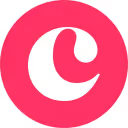HeyReach Alternatives
Explore 10 HeyReach alternatives. This guide compares features, pricing, and use cases to help you find the right outreach tool for your business.
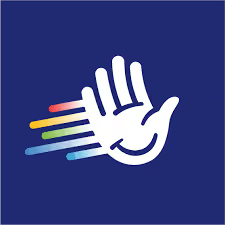
You might be using HeyReach for its LinkedIn outreach capabilities. The tool performs well for scaling campaigns and managing multiple accounts from a single dashboard, which is why many sales teams and agencies adopt it for lead generation.
Despite its strengths, some users report occasional integration issues or find campaign management could be improved. We've analyzed the top alternatives to help you find the right fit for your needs. Let's get started.
Try 11x for Your Sales Efforts
If you want to use digital workers for your sales efforts, 11x is a relevant option. It automates certain sales functions, which lets your team focus on other tasks. This approach can support your existing sales operations.
11x is a GTM platform that uses AI agents to manage the sales process. Its agent, Alice, finds prospects, runs outreach on email and LinkedIn, and keeps your CRM updated. Another agent, Julian, qualifies inbound leads and books meetings.
The platform replaces the need for separate tools for data enrichment, outreach, or email warmup by unifying these functions. This can reduce the number of applications in a traditional GTM stack.
HeyReach Alternatives
Here is a detailed breakdown of the main alternatives to HeyReach. We analyze each option's pricing, features, and specific pros and cons to help you find a suitable replacement.
1) Expandi
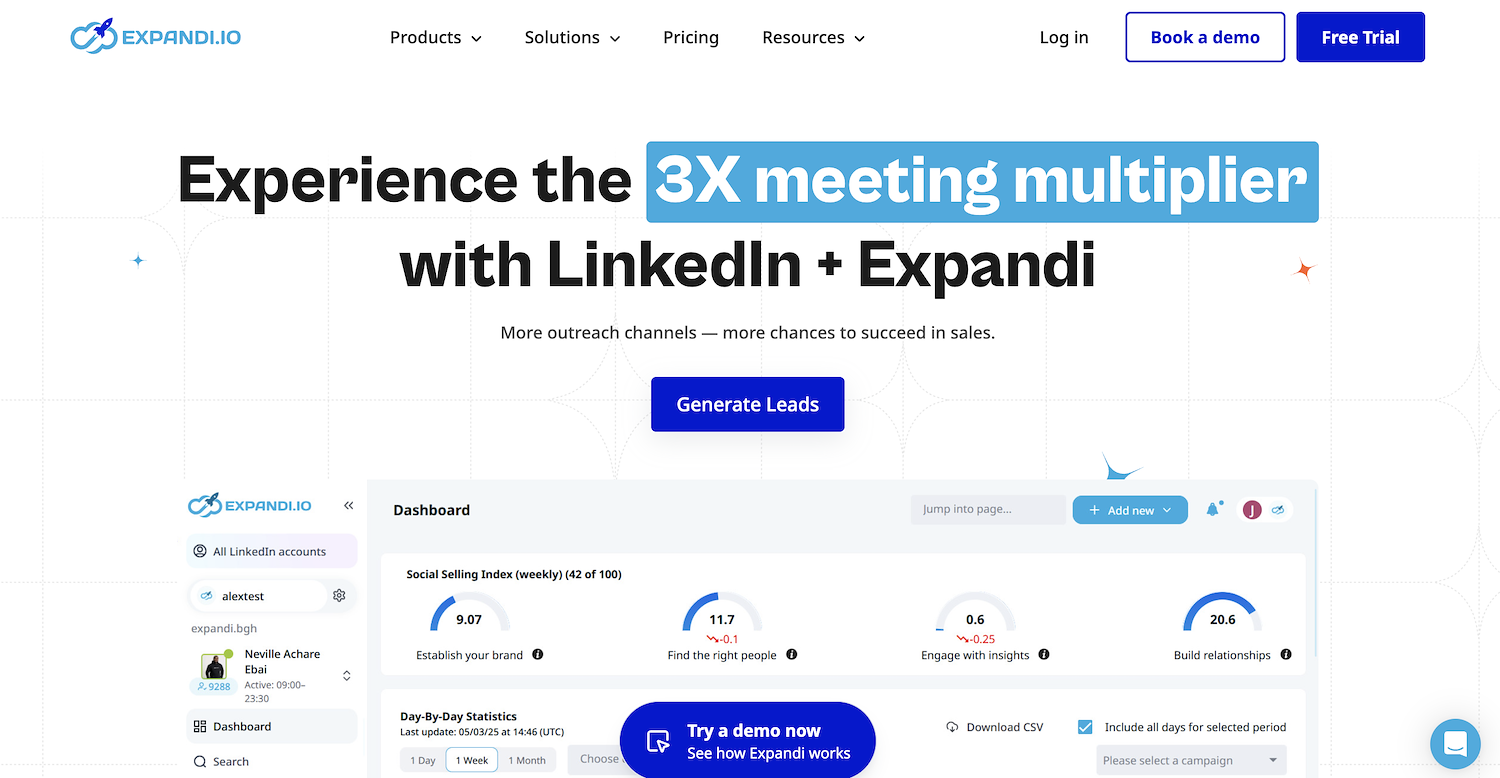
Expandi is a cloud-based platform for LinkedIn automation and multichannel outreach. It combines LinkedIn, email, and media into automated sequences. The tool helps bypass LinkedIn limits and scrapes audiences from groups, events, and posts. It runs campaigns without code or browser extensions.
The platform is used for lead generation through omnichannel cold outreach and automated follow-ups. It is designed for sales teams, agencies with multiple clients, and recruiters.
Expandi's Main Features
The platform includes a visual campaign builder that uses drag-and-drop flows with 10 actions and 10 conditions, including pre-outreach warm-up actions like profile visits.
It allows sending up to 300 connection requests weekly and has a campaign-priority engine to allocate daily LinkedIn limits to the best-performing campaigns.
A paid add-on enables dynamic personalization with images, videos, and GIFs through direct integrations with Sendspark and Hyperize.
It offers workspaces with shared dashboards, roles, and permission management for teams and agencies to manage multiple LinkedIn accounts from one login.
How Expandi Compares to HeyReach
Average Review score: 4.2/5 stars based on 113 G2 reviews.
Expandi offers a visual campaign builder with more warm-up actions. For instance, you can automatically visit a profile or endorse a skill before you send a connection request, which is a more detailed approach than HeyReach's campaign setup.
It combines LinkedIn and email outreach into a single automated sequence. This provides a more integrated omnichannel approach compared to HeyReach, which focuses primarily on LinkedIn.
The tool allows for dynamic personalization with images and GIFs in your messages through an add-on. This feature can make your outreach more engaging than the standard text-based messages in other tools.
This platform includes specific features for LinkedIn events. You can use it to invite your network to an event or message all attendees, a capability not typically found in standard LinkedIn outreach tools.
Potential Drawbacks Compared To HeyReach
The platform's dynamic personalization with images is a paid add-on. This can increase the total cost compared to HeyReach, which may include similar features in its base price.
Some users report occasional delays on the cloud-based platform. This can impact the speed of large campaigns, a point of difference from HeyReach's focus on scalability.
The tool's lead management functionality can be less intuitive for some users. HeyReach, in comparison, provides a more focused dashboard for managing multiple accounts and campaigns.
Pricing and Budget Considerations
User reviews indicate a high perceived cost for both Expandi and HeyReach. While HeyReach uses a fixed-cost model for unlimited senders, specific pricing for Expandi is not publicly detailed. For the most accurate and up-to-date pricing information, we recommend visiting Expandi's official website.
2) Zopto
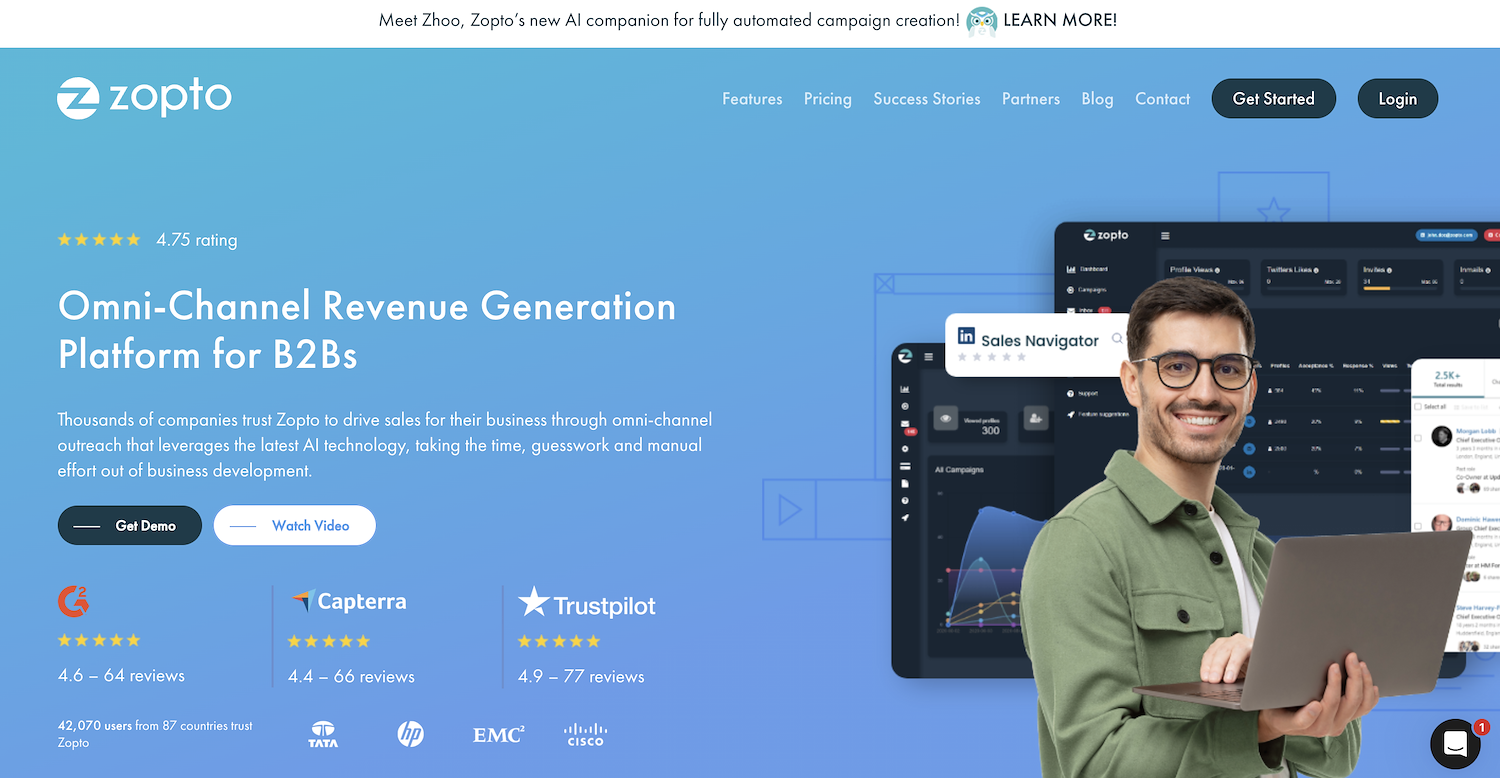
Zopto is an omni-channel platform for B2B firms that automates LinkedIn and email outreach. It uses GPT-4 to create and manage campaigns and supplies real-time analytics for teams to scale lead-generation without manual work.
Its main use is for outbound lead-generation and to set appointments. The platform also supports account-based marketing and social selling workflows for sales teams, agencies, and entrepreneurs.
Zopto's Main Features
The Zhoo AI Assistant uses GPT-4 to build campaigns, write templates, schedule posts, and generate automatic responses in the inbox.
Its omnichannel smart sequences combine LinkedIn actions like invites and profile views with up to 5,000 verified email sends per month.
The platform provides advanced filtering with hundreds of data points and uses AI to clean prospect lists for accuracy.
A LinkedIn post scheduler automates social posts and includes a ChatGPT-4 content generator for creating personalized content.
How Zopto Compares to HeyReach
Average Review score: 4.5/5 stars based on 71 G2 reviews.
Zopto includes the Zhoo AI Assistant, which uses GPT-4 to build campaigns and write content. This provides more AI-driven support for content creation compared to HeyReach's focus on campaign execution.
The platform integrates email outreach directly into its smart sequences, allowing up to 5,000 verified email sends monthly. This offers a more unified omnichannel approach than HeyReach, which centers on LinkedIn outreach.
It offers a scheduler for LinkedIn posts with a GPT-4 content generator. This feature supports social selling through automated content, an area not covered by HeyReach's core outreach functions.
This tool provides advanced filtering options and uses AI to clean prospect lists. This can result in more accurate prospect selection compared to the standard list management in HeyReach.
Potential Drawbacks Compared To HeyReach
Some users report that Zopto can experience slow performance. This might affect the management of large-scale campaigns, an area where HeyReach is designed for efficiency.
The platform's pricing is perceived as high by some users. This contrasts with HeyReach's fixed-cost model, which can be more predictable for agencies managing many accounts.
Zopto's campaign management can sometimes present issues with its API or statistics. In comparison, HeyReach provides a focused dashboard for managing multiple accounts and scaling campaigns.
Pricing and Budget Considerations
User reviews place both tools in a high price bracket. HeyReach's fixed-cost model for unlimited senders offers predictable costs for agencies, while Zopto's specific pricing is not public. For the most accurate and up-to-date information, we recommend visiting Zopto's official website.
3) Meet Alfred
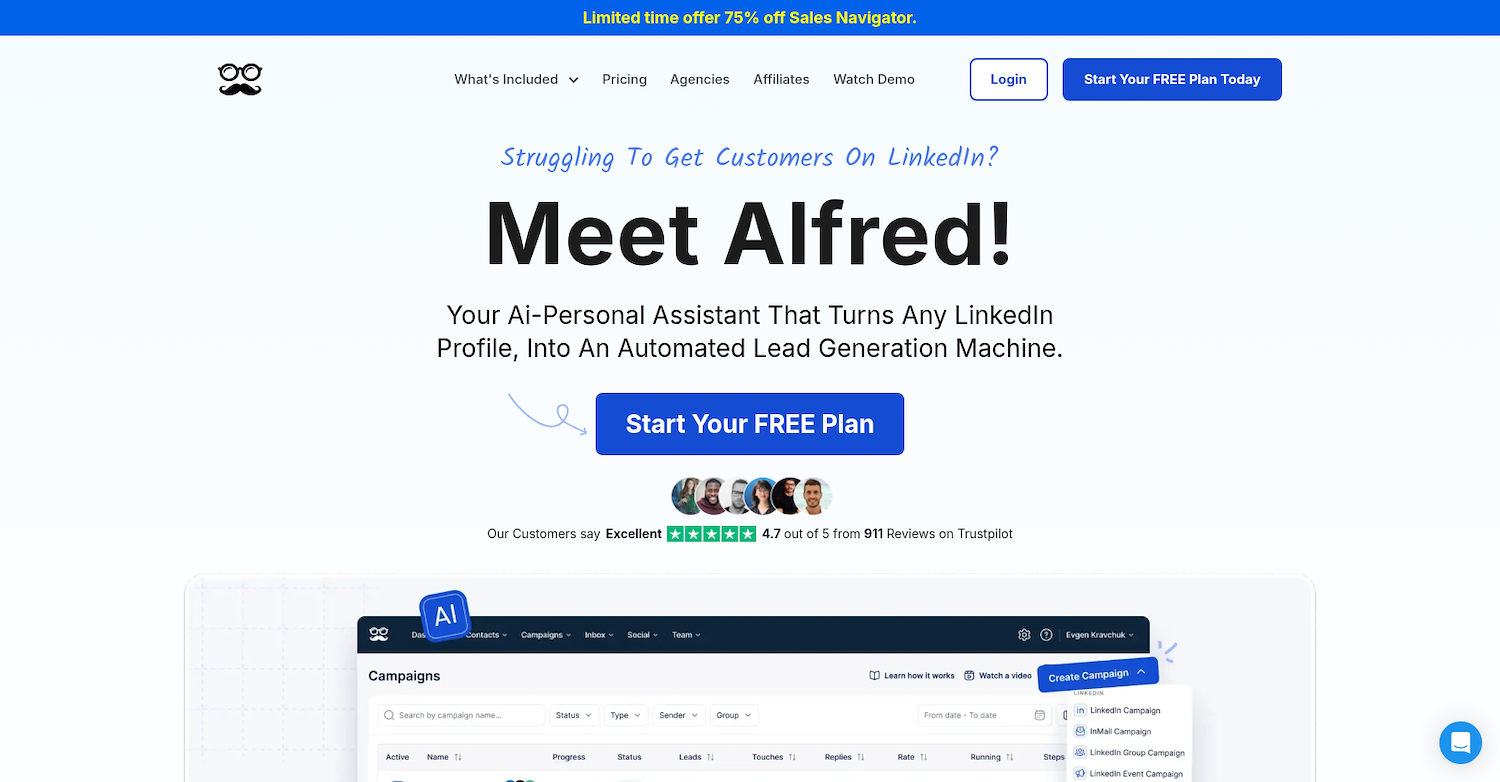
Meet Alfred is a multi-channel outreach platform that automates work on LinkedIn, Email, and X (Twitter). It acts as a virtual sales representative to find leads, send follow-ups, and manage conversations for sales teams and agencies.
The tool automates LinkedIn connection requests and combines touchpoints from different channels into one sequence. It also centralizes prospect conversations and schedules social media posts to support outbound growth and white-label services.
Meet Alfred's Main Features
The platform builds multichannel sequences that combine LinkedIn, Email, and X (Twitter) touchpoints into a single campaign.
It includes a LinkedIn CRM for managing and growing your network directly within the platform.
A social media post scheduling tool lets you plan and automate content for your social profiles.
The tool provides a white-label solution, which allows agencies to offer the service under their own brand.
How Meet Alfred Compares to HeyReach
Average Review score: 3.3/5 stars based on 32 G2 reviews.
Meet Alfred builds multichannel campaigns that use LinkedIn, Email, and X (Twitter). This offers a broader outreach scope than HeyReach, which focuses on LinkedIn.
It includes a built-in LinkedIn CRM to manage your network. This provides a more integrated contact management system compared to HeyReach's campaign-focused dashboard.
The tool offers a social media post scheduler. This adds a content marketing function that is not part of HeyReach's core outreach features.
For agencies, Meet Alfred provides a white-label solution. This allows them to offer the service under their own brand, a feature not specified for HeyReach.
Potential Drawbacks Compared To HeyReach
Meet Alfred sometimes limits campaign quotas on its lower-tier plans. This can be a constraint for agencies that need to scale outreach, an area where HeyReach is designed for high-volume campaigns across many accounts.
Some users report that the platform can trigger LinkedIn detection flags. This may create a risk for account safety, which contrasts with HeyReach's focus on secure, large-scale account management.
Its customer support is sometimes described as slow or inconsistent. For teams that need quick help to resolve campaign issues, this can be a point of friction compared to the support needed for large operations.
Pricing and Budget Considerations
HeyReach offers a fixed-cost model for unlimited senders, providing predictable costs for agencies. While specific pricing for Meet Alfred is not public, user reviews suggest a tiered model that may be more cost-effective for smaller teams. For the most accurate information, visit Meet Alfred's official website.
4) Dux-Soup

Dux-Soup is a Chrome extension that automates lead generation on LinkedIn. The tool works inside your browser to find prospects and engage them through automated actions. It supports sales teams and recruiters with their outreach efforts.
The extension can visit profiles, send connection requests, and message new connections. These actions help construct a sales pipeline through direct prospect engagement on the LinkedIn platform.
Dux-Soup's Main Features
The tool auto-views, follows, and endorses profiles to warm up prospects before outreach begins.
It automatically removes prospects from a drip campaign as soon as they reply to a message.
The platform pushes new leads to CRMs like Salesforce and HubSpot through native and Zapier/Make integrations.
It offers a browser extension for on-device automation and a cloud edition for continuous operation from any location.
How Dux-Soup Compares to HeyReach
Average Review score: 4.3/5 stars based on 82 G2 reviews.
Dux-Soup provides both a browser extension and a cloud-based option. This gives more flexibility than HeyReach's platform-only approach, as you can choose to run automation directly in your browser.
The tool includes pre-outreach actions like profile visits and skill endorsements. This allows for a more subtle warm-up sequence compared to HeyReach, which centers on direct connection requests and messages.
It offers direct integrations to push lead data into CRMs like Salesforce or HubSpot. This creates a more connected workflow for sales teams compared to lead management primarily within the HeyReach dashboard.
This tool automatically stops a campaign for a prospect once they reply. This feature helps avoid unnecessary follow-ups, which may require manual intervention in other platforms.
Potential Drawbacks Compared To HeyReach
Dux-Soup's browser-based automation requires your computer to be on for campaigns to run. This is different from HeyReach, which is a cloud platform built to manage many accounts from a central dashboard without local device dependency.
The tool's campaign management can feel less direct for some users. For example, editing queued messages after a campaign launch can be difficult. HeyReach, by comparison, provides a dashboard focused on large-scale campaign management and oversight.
It may offer fewer features for team collaboration compared to platforms built for agencies. Some users report that the cloud version lacks team campaign functions. HeyReach, in contrast, centers its design on agency use and multi-account management.
Pricing and Budget Considerations
Dux-Soup's tiered per-seat pricing, starting at $11.25 per month, is cost-effective for individuals, while HeyReach's fixed-cost model for unlimited senders benefits larger agencies. This makes Dux-Soup a more accessible entry point for solo users, whereas HeyReach is structured for scaling teams. For a full breakdown of plans, you can review pricing on Dux-Soup's official website.
5) Octopus CRM
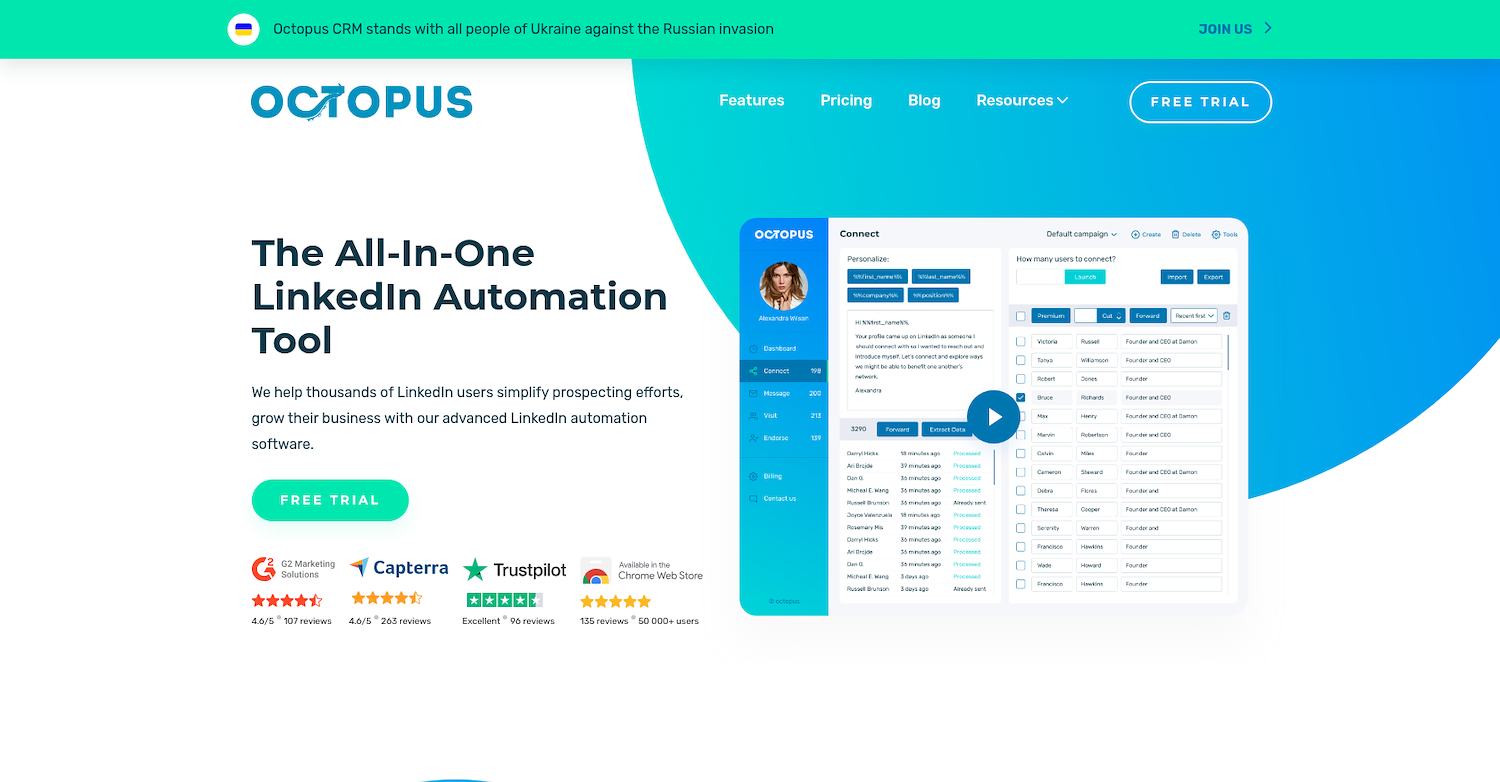
Octopus CRM is a LinkedIn automation tool used to prospect and build marketing funnels. It automates connection requests, mass messages, skill endorsements, and profile views. The platform is for sales teams, marketers, and recruiters who use LinkedIn for lead generation.
Octopus CRM's Main Features
The platform sends connection requests via email, which allows users to bypass LinkedIn's weekly invitation limit.
It automatically endorses up to seven skills on a contact's profile before sending outreach messages.
A drag-and-drop campaign builder creates multi-step funnels by combining actions like profile visits and follow-up messages.
The tool integrates with Zapier and HubSpot, which lets you push lead data into other applications for reporting.
How Octopus CRM Compares To HeyReach
Average Review score: 4.4/5 stars based on 116 G2 reviews.
Octopus CRM sends connection requests through email, which helps bypass LinkedIn's weekly invitation limit. This is a different approach compared to HeyReach's focus on direct platform outreach.
The tool automatically endorses up to seven skills on a prospect's profile. This action warms up contacts before outreach, a more subtle approach than HeyReach's direct messaging focus.
Its pricing starts at a lower point, which makes it accessible for individual users. This contrasts with HeyReach's model, structured for larger agencies that manage many accounts.
It provides a visual funnel builder to combine actions like profile visits and follow-up messages. This offers a more structured way to build a sequence compared to HeyReach's campaign setup.
Potential Drawbacks Compared To HeyReach
Octopus CRM uses a split interface with a web app and a browser extension. Some users find this less efficient for managing multiple accounts compared to HeyReach's unified dashboard, which is designed for agencies.
Its reporting features may seem less detailed for some users. This is different from HeyReach, which provides a dashboard with analytics designed for overseeing large-scale campaigns and making data-driven decisions.
The tool's structure is often better for individual users. HeyReach, in contrast, is built for agencies with a model that supports unlimited accounts and large-scale team operations without per-user costs.
Pricing and Budget Considerations
Octopus CRM's tiered pricing starts at $6.99 per month, making it a cost-effective choice for individuals. In contrast, HeyReach's fixed-cost model is better suited for agencies that need to manage unlimited accounts with predictable expenses. For the most current pricing information, we recommend visiting the official Octopus CRM website.
Consider 11x for Your Sales Team
If you are exploring digital workers for your sales process, consider 11x. The platform uses AI agents to handle prospecting, outreach, and CRM updates. This approach allows your team to concentrate on closing deals and can support your existing sales structure. See if it fits your strategy.
11x uses AI agents to manage the sales process. Alice finds accounts, enriches data, and runs outreach, while Julian qualifies leads and books meetings. The platform replaces multiple tools in a traditional GTM stack by unifying these functions.
Book a demo to see the platform in action.
6) Salesflow
Salesflow is a LinkedIn automation platform that helps sales teams and agencies with lead generation. It automates outreach campaigns and manages prospects from a central dashboard, which supports consistent engagement with potential clients.
The tool is used to build prospect lists and run automated sequences on LinkedIn. It also provides analytics to track campaign performance and manage team activities, which helps in organizing sales outreach efforts.
Salesflow's Main Features
The platform offers advanced filtering to build targeted prospect lists from LinkedIn Sales Navigator searches.
It provides a centralized dashboard for creating and managing campaigns, with analytics to monitor performance.
For agencies, it includes team management features to handle multiple client accounts from a single login.
The tool has built-in safety limits and randomized delays to mimic human activity and protect LinkedIn accounts.
How Salesflow Compares to HeyReach
Average Review score: 4.5/5 stars based on 131 G2 reviews.
Salesflow provides detailed reporting and team management features designed for agencies. This offers a structured way to oversee client campaigns, which is a core focus similar to HeyReach.
The platform emphasizes account safety with features like randomized delays and activity limits. This approach is designed to reduce the risk of LinkedIn restrictions during outreach campaigns.
It offers a dedicated account manager and support, which can be a benefit for teams that need hands-on assistance. This differs from platforms that rely more on self-service support models.
The tool's workflow is built around creating and managing prospect lists directly within the platform. This can offer a more integrated list-building process compared to importing lists in other tools.
Potential Drawbacks Compared To HeyReach
Salesflow's pricing is typically on a per-seat basis. This can become more expensive for large agencies compared to HeyReach's fixed-cost model for unlimited accounts.
Some users may find the initial setup and learning curve to be more involved. HeyReach is often noted for its straightforward interface for launching campaigns quickly.
The platform's focus is primarily on LinkedIn. It does not offer the native multi-channel sequences found in some other alternatives, a point of difference from tools that bundle channels.
Pricing and Budget Considerations
Salesflow operates on a per-seat pricing model, which can be a significant factor for agencies scaling their teams. This contrasts with HeyReach's fixed-cost structure for unlimited senders. For detailed pricing, it is best to visit the official Salesflow website.
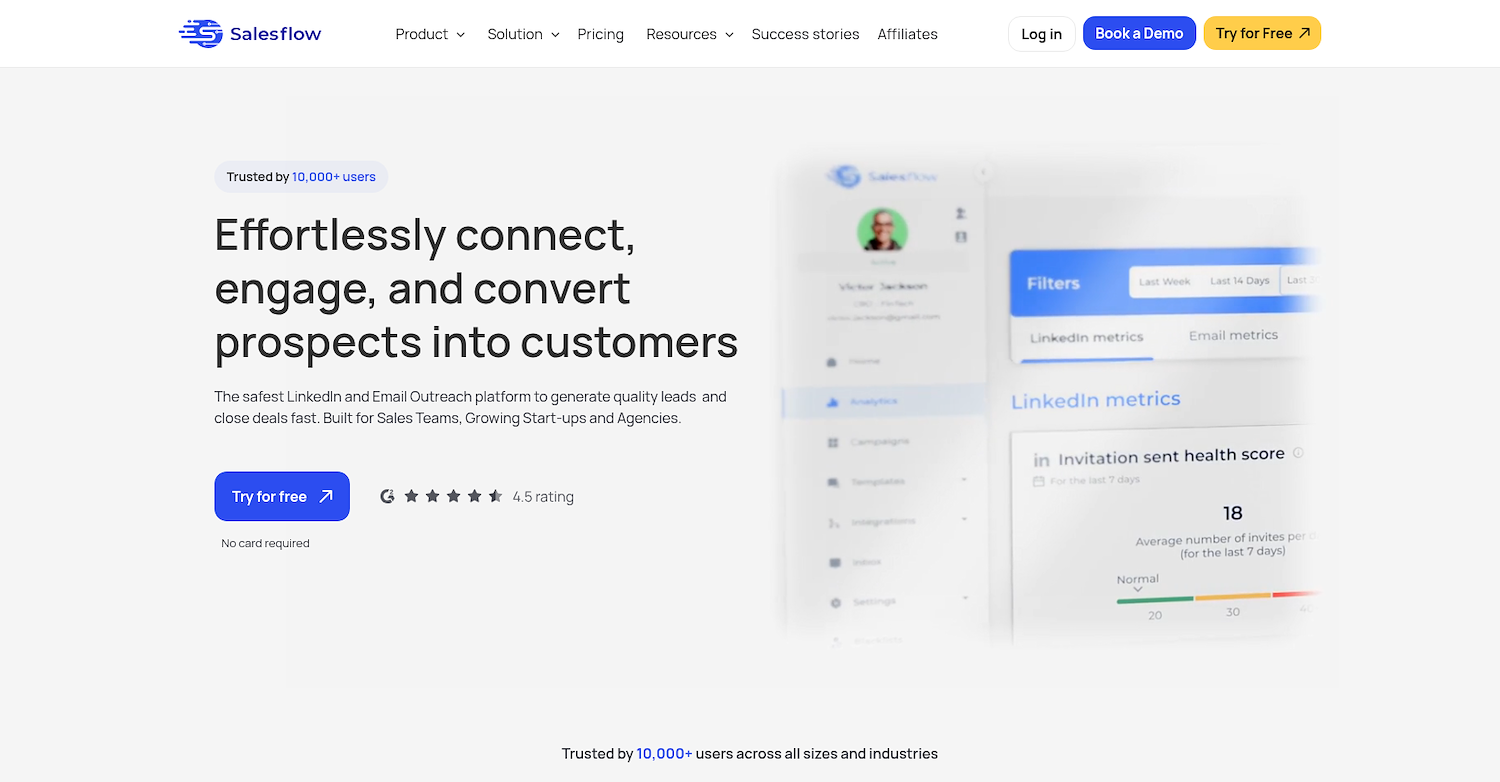
Salesflow is a LinkedIn automation platform that helps sales teams and agencies generate leads. It automates outreach and manages prospects from a central dashboard to support consistent engagement with potential clients.
The tool builds prospect lists and runs automated sequences on LinkedIn. It also provides analytics to track campaign performance and manage team activities to organize sales outreach.
Salesflow's Main Features
The platform automates LinkedIn actions, including connection requests, messages, InMails, profile views, post likes, and skill endorsements.
It includes a unified inbox to manage all campaign conversations using templates, smart filters, and organizational tags.
The tool ensures account safety with cloud-based delivery, dedicated IPs, randomized action timing, and rule-compliant limits.
A quick-start interface allows users to launch a new campaign in under four minutes through a three-step process.
How Salesflow Compares To HeyReach
Average Review score: 4.3/5 stars based on 132 G2 reviews.
Salesflow includes a unified inbox with templates and tags to manage all conversations. This centralizes communication, which is different from HeyReach's focus on campaign-level management.
It automates a wider range of LinkedIn actions, including post likes and skill endorsements. This provides a more subtle warm-up strategy than the direct outreach methods central to HeyReach.
The tool provides specific safety features like dedicated IPs and randomized action timing. This offers a detailed approach to account security, while HeyReach is built more for general campaign scalability.
A quick-start interface allows users to launch a campaign in under four minutes. This can be more direct for initial setup than navigating the agency-focused dashboard in HeyReach.
Potential Drawbacks Compared To HeyReach
Some users report that the software can be buggy, which might cause daily operational issues. This is different from HeyReach, which provides a stable platform for managing large-scale campaigns without frequent interruptions.
Salesflow sometimes has data accuracy issues, according to user feedback. This can affect the quality of prospect lists, while HeyReach's system supports reliable data management for high-volume outreach.
The tool may lack certain features for large-scale agency management. HeyReach, for instance, offers a more comprehensive suite of tools for overseeing hundreds of client accounts from a single, unified interface.
Pricing and Budget Considerations
Salesflow’s per-seat pricing model means costs scale with the number of users, which is a key difference from HeyReach's fixed-cost plan for unlimited senders. This makes HeyReach more predictable for large agencies, while Salesflow may be more economical for smaller teams. For exact costs, visit the official Salesflow website.
7) Skylead

Skylead is a cloud-based sales engagement tool that combines LinkedIn automation and cold email outreach. It finds business emails and creates smart sequences for lead generation.
Sales teams, agencies, and recruiters use the platform to automate their outreach process. This helps them connect with prospects across multiple channels and book more meetings.
Skylead's Main Features
The platform features a visual campaign builder that uses if/else conditions to adapt sequence steps based on a lead's behavior.
It discovers and verifies business email addresses on-the-fly within a sequence to help prevent bounces.
The tool auto-generates personalized images and GIFs using prospect data like names and logos to use in outreach.
It connects to unlimited email accounts and includes an automatic warm-up feature to improve deliverability and avoid spam folders.
How Skylead Compares to HeyReach
Average Review score: 4.5/5 stars based on 126 G2 reviews.
Skylead provides a visual campaign builder that uses if/else conditions. This creates more adaptive outreach sequences based on a lead's behavior, which is different from HeyReach's more direct campaign structure.
It includes a built-in email finder and verifier to discover business emails during a sequence. This contrasts with platforms like HeyReach, where data enrichment is often a separate process.
The tool automatically generates personalized images and GIFs from prospect data. This adds a visual element to outreach that is not a standard feature in HeyReach's system.
This platform connects to unlimited email accounts and includes a free warm-up feature. This offers more support for email-heavy campaigns compared to HeyReach's primary focus on LinkedIn.
Potential Drawbacks Compared To HeyReach
Skylead's per-account pricing model can be costly for agencies that manage many clients. HeyReach, in contrast, offers a fixed-cost plan for unlimited senders, which provides more predictable expenses for large-scale operations.
Some users report that the platform has a bit of a learning curve. This can make the initial setup process more involved compared to HeyReach, which is often noted for its straightforward dashboard.
The tool lacks native CRM integrations, according to some user feedback. This may require manual data transfers, while HeyReach provides a more unified system for managing campaigns and accounts within its dashboard.
Pricing and Budget Considerations
Skylead's All-In-One plan is $100 per month per account. This per-seat model contrasts with HeyReach's fixed-cost plan for unlimited senders, making HeyReach more predictable for large agencies. For the most current pricing, visit Skylead's official website.
8) We-Connect

We-Connect is a cloud-based automation tool for LinkedIn. It is designed for sales teams and agencies to manage their lead generation efforts. The platform automates outreach sequences, such as connection requests and messages, to build a sales pipeline. It provides a central place to run and monitor campaigns.
We-Connect's Main Features
The platform includes lead monitoring and analytics for performance tracking.
It captures data from social media and websites and allows for data export and import.
The tool offers personalization features with customizable templates.
It provides forms for lead capture to support data collection.
How We-Connect Compares To HeyReach
Average Review score: 4.6/5 stars based on 83 G2 reviews.
We-Connect captures data from social media and websites. This provides a broader source for leads compared to HeyReach, which centers on LinkedIn data.
It includes lead capture forms to collect data directly. This is a different approach from HeyReach, which typically works with pre-existing prospect lists.
The tool offers lead monitoring with detailed analytics. This feature tracks individual prospect engagement, which differs from the campaign-level oversight in HeyReach.
This platform provides customizable templates for personalization. This helps tailor messages for different segments, a more granular approach than HeyReach's focus on large-scale campaign execution.
Potential Drawbacks Compared To HeyReach
We-Connect uses a per-seat pricing model, which can increase costs for large teams. This is different from HeyReach's fixed-cost structure that supports unlimited accounts for agencies and offers more predictable expenses.
Some users report occasional performance delays on the platform. This might affect the speed of large-scale campaigns, while HeyReach is built to handle high-volume outreach across many accounts efficiently.
The tool's user interface may seem less direct for managing many client accounts at once. In comparison, HeyReach offers a centralized dashboard designed specifically for agency workflows and multi-account oversight.
Pricing and Budget Considerations
We-Connect's pricing starts at $69 per seat per month, a model suited for individuals and smaller teams. In contrast, HeyReach uses a fixed-cost structure for unlimited senders, which offers predictable costs for large agencies. For the most current pricing details, it is best to visit the official We-Connect website.
9) Waalaxy
Waalaxy is an automation tool for LinkedIn and email outreach. It helps users contact prospects through automated sequences that combine actions from both channels. The platform is designed for sales teams, marketers, and recruiters to manage their lead generation activities.
Waalaxy's Main Features
The platform builds multi-channel campaigns that combine LinkedIn actions with email follow-ups in a single sequence.
It includes a feature to find and verify professional email addresses, which helps in bypassing LinkedIn's weekly connection limits.
The tool offers pre-built campaign templates that are designed for different outreach goals to help users get started quickly.
It operates from the cloud, which allows campaigns to run continuously without requiring the user's computer to be on.
How Waalaxy Compares to HeyReach
Average Review score: 4.6/5 stars based on 540+ G2 reviews.
Waalaxy integrates email outreach directly into its sequences. This provides a native multi-channel function that is different from HeyReach's primary focus on LinkedIn.
It offers a method to bypass LinkedIn's weekly invitation limits by using email-based connection requests. This is a specific tactic not central to HeyReach's outreach model.
The tool provides pre-built campaign templates. This can simplify the setup process for users, while HeyReach is geared toward custom campaign creation for large-scale agency needs.
This platform is often noted for its user-friendly interface. This can be an advantage for individuals or small teams, whereas HeyReach's dashboard is built for managing many accounts.
Potential Drawbacks Compared To HeyReach
Some users report that the email enrichment feature can occasionally provide inaccurate data. This may affect the reliability of multi-channel campaigns, an area where HeyReach focuses on consistent LinkedIn data.
The platform's team management features may be less comprehensive for large agencies. HeyReach, in contrast, is designed with a focus on multi-account management and agency workflows.
Its analytics might not be as detailed for users who need in-depth reporting across many client accounts. HeyReach provides a dashboard with analytics suited for agency-level oversight.
Pricing and Budget Considerations
Waalaxy offers a tiered, per-seat pricing model, including a free plan. This makes it accessible for individuals and small teams. HeyReach's fixed-cost model for unlimited senders is more predictable for large agencies. For current pricing, visit the official Waalaxy website.

Waalaxy is an automation tool for LinkedIn and email outreach. It helps users contact prospects through automated sequences that combine actions from both channels. The platform supports lead generation for sales teams, marketers, and recruiters.
Waalaxy's Main Features
Builds multi-channel prospecting sequences by letting users choose the conditions, contact channels, and messages.
Includes a native inbox to manage LinkedIn messages with templates and scheduling inside the platform.
Finds and exports prospect data for integration with external CRM tools.
Triggers actions on the platform based on external conditions from other connected tools.
How Waalaxy Compares to HeyReach
Average Review score: 4.6/5 stars based on 530 G2 reviews.
Waalaxy integrates email outreach directly into its sequences. This provides a native multi-channel function, which is different from HeyReach's primary focus on LinkedIn.
It includes a native inbox to manage LinkedIn messages with templates and scheduling. This offers a more centralized way to handle conversations compared to HeyReach's campaign-level management.
The tool uses triggers to start actions based on events in other connected applications. This allows for more complex automation workflows than the standard campaign setup in HeyReach.
This platform finds and verifies professional email addresses within a campaign. This contrasts with HeyReach, where data enrichment is typically a separate step before you start outreach.
Potential Drawbacks Compared To HeyReach
Waalaxy uses a per-seat pricing model, which can increase costs for large teams. This is different from HeyReach's fixed-cost structure that supports unlimited accounts and offers more predictable expenses for agencies.
Some users report that the platform can have technical issues. This might affect campaign stability, while HeyReach is built for consistent performance across many accounts.
The tool's user interface may seem less direct for managing many client accounts at once. In comparison, HeyReach offers a centralized dashboard designed specifically for agency workflows and multi-account oversight.
Pricing and Budget Considerations
Waalaxy’s per-seat pricing, which starts with a free plan and has paid tiers from $21 per month, is cost-effective for individuals and small teams. This contrasts with HeyReach's fixed-cost model for unlimited senders, which offers predictable budgeting for large agencies. For the most current pricing, visit the official Waalaxy website.
10) Reply.io
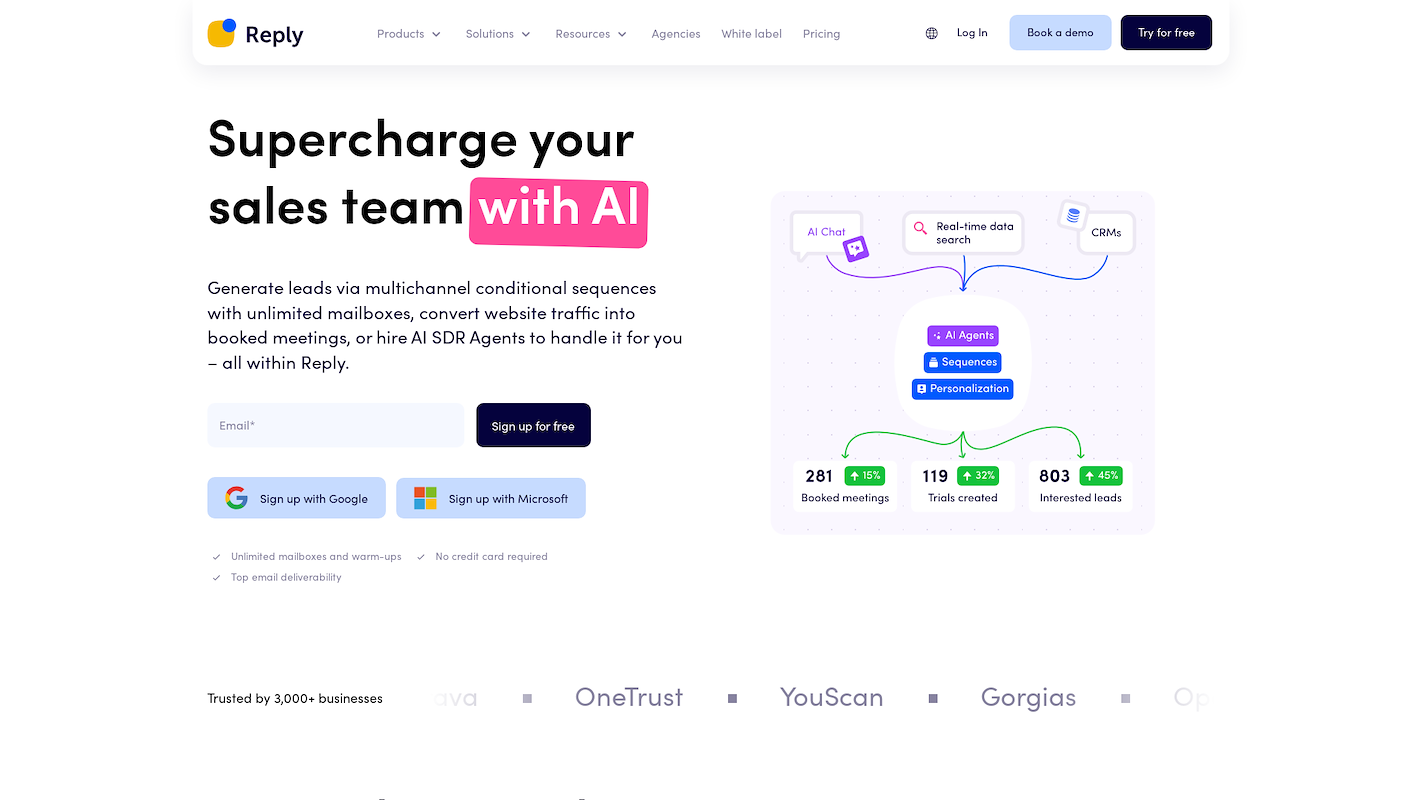
Reply.io is a sales engagement platform that automates outreach across multiple channels, including email, LinkedIn, calls, and messages. It helps sales teams find prospects, generate leads, and book meetings from a single place.
The tool supports various sales motions, such as outbound, inbound, and account-based marketing. It is also used by agencies to manage client campaigns.
Reply.io's Main Features
The platform provides analytics to track email open rates, link activity, and attachment engagement for performance monitoring.
It includes integrated workflow management to build, automate, and report on sales engagement sequences.
The tool supports multiple outreach options, allowing for sequences that combine email, calls, and other touchpoints.
A task management system is built into the platform to help organize and execute sales activities.
How Reply.io Compares to HeyReach
Average Review score: 4.6/5 stars based on 1,458 G2 reviews.
Reply.io supports outreach across email, LinkedIn, calls, SMS, and WhatsApp. This provides a broader channel selection compared to HeyReach, which focuses primarily on LinkedIn.
It includes an AI chat tool for websites to capture leads. This is a feature for inbound lead generation not found in HeyReach's outbound-focused toolkit.
The platform offers an email deliverability suite with technical monitoring for SPF, DKIM, and DMARC. This gives more control over email health than the standard email features in other tools.
This tool uses AI SDR Agents to automate the outreach process, from finding prospects to handling responses. This is a more comprehensive use of AI compared to HeyReach's campaign execution focus.
Potential Drawbacks Compared To HeyReach
Reply.io uses a per-user pricing model, which can become costly for large agencies. This is different from HeyReach's fixed-cost structure that provides predictable expenses for managing unlimited accounts.
Some users report a learning curve with the platform because of its extensive multi-channel features. In comparison, HeyReach's specific focus on LinkedIn automation offers a more direct user experience.
The tool's broad focus on sales engagement means its LinkedIn features may feel less specialized. HeyReach, in contrast, is built specifically for high-volume LinkedIn outreach and multi-account management for agencies.
Pricing and Budget Considerations
Reply.io offers a free plan and paid tiers starting at $49 per user per month, making it accessible for individuals. In contrast, HeyReach's fixed-cost model for unlimited senders provides predictable budgeting for large agencies. For the most current pricing, visit the official Reply.io website.
Which One Should You Go With?
Choosing a HeyReach alternative involves many variables specific to your needs. This guide shared several options, analyzing their features, pricing, and potential drawbacks to help you decide.
If you are exploring digital workers for your sales process, consider 11x. The platform uses AI agents to handle prospecting, outreach, and CRM updates, which allows your team to concentrate on closing deals and can support your existing sales structure.




